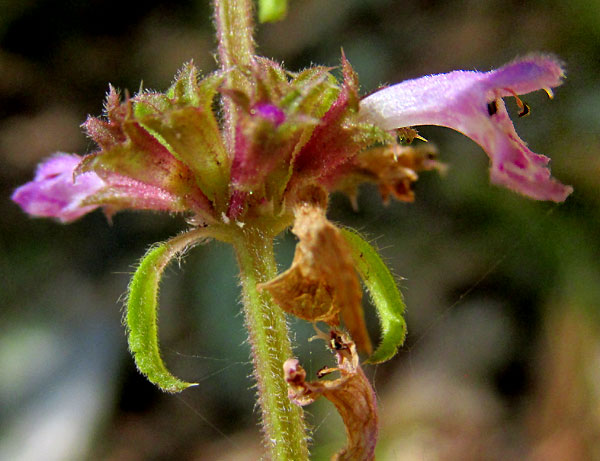Excerpts from Jim Conrad's
Naturalist Newsletter
entry from field notes dated July 2, 2022, taken on Cerro de la Cruz, at an elevation of ~2885m (~9465 ft), just south of the community of El Pinar, Amealco de Bonfil, Querétaro, MÉXICO, (~N20.17°, ~W100.17°)
"KEERL'S" HEDGE NETTLE
 At the mouth of a valley opening toward the east and mantled with oak forest, the herb shown at the right arose from a thick carpet of oak leaves covering an outcrop of limestone. Throughout most of the day this spot is shady, but around noon the very slender, sparsely leafed plant seems to stretch toward sunlight.
At the mouth of a valley opening toward the east and mantled with oak forest, the herb shown at the right arose from a thick carpet of oak leaves covering an outcrop of limestone. Throughout most of the day this spot is shady, but around noon the very slender, sparsely leafed plant seems to stretch toward sunlight.

When individual flowers or leaves arise densely clustered around one spot on a stem, similar to what this plant's flowers are seen doing at the left, the clusters are referred to as verticils. Our plant's clusters look like verticils but, if you'd look very closely, you'd see that actually the flowers are grouped in two cyme-type clusters, one on each side of the stem, just crowded together in a way that they look like true verticils. Such groupings are called "verticillasters." That may seem like nit-picking, but in botany figuring out something's identity often depends on such precision of definitions. Anyway, this plant's verticil-like verticillasters grow closer together toward the stem's top.
Even at a distance anyone familiar with a variety of Mint Family species will recognize our plant as "typically a mint." Leaves arising opposite one another on the stem, undivided leaves with neatly toothed margins, plus those verticillasters arranged closer to one another at the stem's tip, all speak of the big Mint Family, the Lamiaceae. The Mint Family's ~3500 species occur worldwide, but mostly in the Mediterranean region and southwestern Asia. Of course mint species usually are aromatic, so they've always attracted human attention.

This plant's flowers also are typical of the mints. They're bilaterally symmetrical in such a way that the blossom's right side is a mirror image of the left side, but the top is different from the bottom -- they're "zygomorphic." Another feature of our plant's flowers, one providing a clue as to which of the Mint Family's 220 or so genera our plant belongs to, is shown at the right: The corolla's upper lip more or less points straight out, while the lower lip bends down, forming a landing pad for pollinators. Also in this picture you can see that the stem is somewhat square in cross section -- a feature of the Mint Family -- and nearly all the plant's parts are hairy, including the corollas.

At the left, note that the four stamens (black anthers at the tips of pale filaments) are included within the corolla, not extending beyond it. Also, Mint Family species neatly divide into those producing either two or four stamens, and here we can see that our plant has four. The two at the top daub pollen on pollinator backs, and the lower two are for side dusting. In the picture you can also see faint white lines serving as nectar guides to nectar at the corolla's bottom.

And the leaves couldn't look more minty, though my old-man's nose detected no minty odor.
All the above features and more, especially the corolla's upper lip being so straight and stiff, direct us to the genus Stachys, which comprises between 300 and 450 species, and as such is one of the Mint Family's largest genera. With such a difference between estimates of how many species the genus embraces, it's not surprising to learn that taxonomists are having problems defining just what a Stachys is.
At this time the best treatment of the Mint Family in Mexico is in the Flora del Valle de Tehuacán-Chicatlán, covering parts of Oaxaca, Puebla and México states. That work may or may not include all of our mints. However, using its descriptions and keys, of the four Stachys species the study does consider, our plant works out to STACHYS KEERLII. The images of dried and pressed herbarium specimens and live plants found on the Internet match our plant.
Stachys keerlii, endemic just to the highlands of central and southern Mexico from Guanajuato and Michoacán to Oaxaca and Veracruz, bears no English name, but in English members of the genus Stachys often are called hedge nettles, such as the Marsh Hedge Nettle and the Hairy Hedge Nettle. Some species are known as betonies. Since our plant's binomial honors F.W. Keerl, a German who collected plants in Mexico during the 1830s, it begs for the name Keerl's Hedge Nettle.
"Keerl's" Hedge Nettle is described as occurring in forests of oak, pine and juniper, as well as arid scrub, at elevations between 2250-2700 meters (7400-8900 ft), so our plant is higher than usual. There's very little other information about it on the Internet.